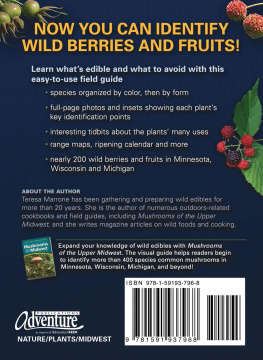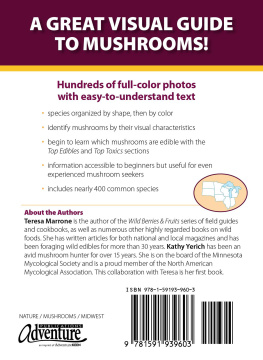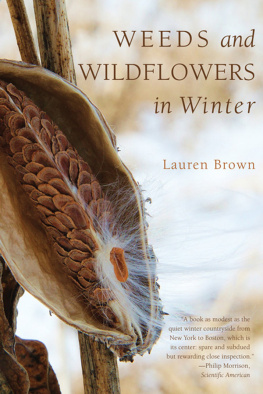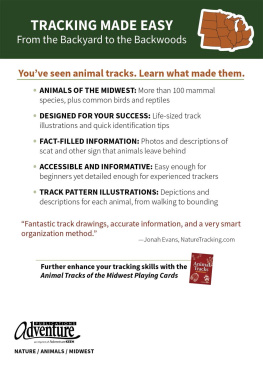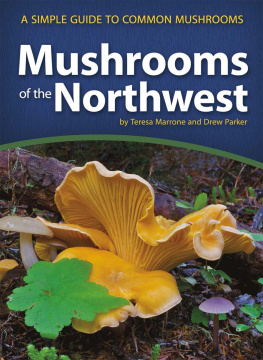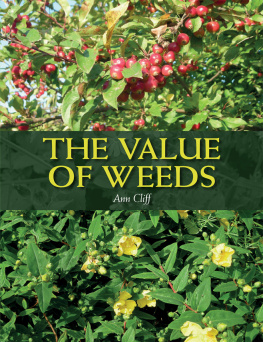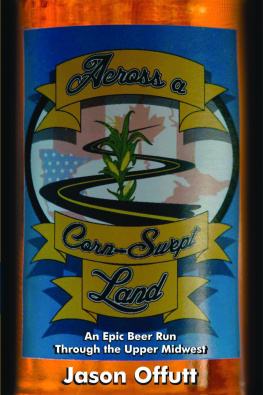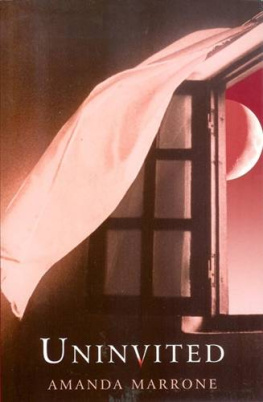Teresa Marrone - Common backyard weeds of the upper midwest
Here you can read online Teresa Marrone - Common backyard weeds of the upper midwest full text of the book (entire story) in english for free. Download pdf and epub, get meaning, cover and reviews about this ebook. year: 2017, publisher: Adventure Publications, Inc., genre: Children. Description of the work, (preface) as well as reviews are available. Best literature library LitArk.com created for fans of good reading and offers a wide selection of genres:
Romance novel
Science fiction
Adventure
Detective
Science
History
Home and family
Prose
Art
Politics
Computer
Non-fiction
Religion
Business
Children
Humor
Choose a favorite category and find really read worthwhile books. Enjoy immersion in the world of imagination, feel the emotions of the characters or learn something new for yourself, make an fascinating discovery.
- Book:Common backyard weeds of the upper midwest
- Author:
- Publisher:Adventure Publications, Inc.
- Genre:
- Year:2017
- Rating:5 / 5
- Favourites:Add to favourites
- Your mark:
- 100
- 1
- 2
- 3
- 4
- 5
Common backyard weeds of the upper midwest: summary, description and annotation
We offer to read an annotation, description, summary or preface (depends on what the author of the book "Common backyard weeds of the upper midwest" wrote himself). If you haven't found the necessary information about the book — write in the comments, we will try to find it.
Common backyard weeds of the upper midwest — read online for free the complete book (whole text) full work
Below is the text of the book, divided by pages. System saving the place of the last page read, allows you to conveniently read the book "Common backyard weeds of the upper midwest" online for free, without having to search again every time where you left off. Put a bookmark, and you can go to the page where you finished reading at any time.
Font size:
Interval:
Bookmark:

Cover, book design and illustrations by Jonathan Norberg
Page layout by Teresa Marrone
Edited by Brett Ortler
Photo credits by photographer and page number:
Cover photos: main photo a Clover; inset photo Groundsel; back cover Ground Ivy
All photos by Teresa Marrone unless noted.
All photos are copyright of their respective photographers.
, Stinkgrass , inset, Steve Matson.
10 9 8 7 6 5 4 3 2 1
Copyright 2017 by Teresa Marrone
Published by Adventure Publications
An imprint of AdventureKEEN
820 Cleveland Street South
Cambridge, Minnesota 55008
(800) 678-7006
www.adventurepublications.net
All rights reserved
Printed in China
ISBN: 978-1-59193-732-6; eISBN: 978-1-59193-706-7
INTRODUCTION
Common Backyard Weeds of the Upper Midwest is written primarily for homeowners, not botanists, farmers or turf managers. Thats not to say that botanists, farmers and turf managers wont find it interesting and useful. What it means is that this book approaches weeds from the laypersons perspective rather than from the perspective of someone who deals with plants professionally.

While youll find a few simple technical terms scattered throughout, plant descriptions are written in plain, simple language that is easy to understand, even if you havent studied botany. Many books approach plants using the classic taxonomic organization. With this system, if you want to identify a weed in your yard, you must first identify the family to which it belongs, then determine the genus and finallyif youre luckythe exact species. So if you have a weedy plant with, say, four white petals, you may have to flip through several chapters to find something that resembles your specimen.
This book is organized by the visual characteristics of the plants, starting first with its growth pattern (creeping and low-growing, upright, vining, grassy) and then considering the color of the flower. Although it is a bit non-scientific (and will no doubt drive botanists crazy), thats the most intuitive way for the non-scientist to identify a plant. Looking at the photos in this book and comparing them to your plant, youll find a dozen or more common weeds whose flowers have four white petals, along with text describing some look-alikes. By studying the photos and accompanying text, you should be able to identify your plant (if it is a common weed, that is)or at least learn enough about it to delve deeper with a more comprehensive reference.
Clear photos show the parts or stages of the plant that will help get you on track to identify it. The text gives enough detail to help you learn what characteristics you need to look at for identification, without being bogged down by a lot of technical terms you may have to scramble to decipher.
Because this book is written for homeowners, it does not include crop pests and other agricultural weeds that are unlikely to appear in the yard or garden. Note that a number of agricultural weeds do, indeed, grow in home settings, and many of those are included in this book.
It also does not include aquatic weeds . Some shoreline weeds that appear in damp areas along lakes or rivers may be found in backyards that abut natural areas (or that have, say, a small pond), so a few of these are included; in particular, Purple Loosestrife is featured because it is a highly invasive shoreline plant that should be eradicated wherever it is foundand that might be your backyard, if your property is close to water.
Shrubs and trees are often weedy, but are not included in this book, which concentrates on non-woody plants. Similarly, mushrooms and other non-vascular plants such as moss and lichens are not discussed; those are subjects for a different book. (For shrubs and trees, I might suggest my series of Wild Berries and Fruits Field Guide books, which are available for all states in this region; each book covers three states in our area. For mushrooms, check out Mushrooms of the Upper Midwest , a photographic ID guide I coauthored with fellow mushroom enthusiast Kathy Yerich. See .)
Determine what type of plant your weed is: creeping or low-growing, upright broadleaf, vine, or grass. Go to the start of that category.
Categories except grasses are organized by the color of the flower , in this order: green, white, yellow, orange, pink/red and purple. Find the start of the appropriate color; for example, broadleaf plants with .
Plants with flowers of a similar color are ordered approximately by the season in which the plant flowers , starting with spring. Study the photos and compare them to your plant; if flowers arent present, you may have to go through the entire category.
Also read the COMPARE information for other plants that have similar attributes to the one in the photos.
Some plants are listed as having edible parts. Please read before eating any weeds.
Most people have heard the common saying that a weed is a plant that is growing where it is not wanted. In many cases, that simple truth says it all. Many of the plants in the book are considered wildflowers, and we enjoy seeing plants such as buttercups, violets or daisies growing wild in the woods. When they settle into our gardens and carefully landscaped areas, however, we often consider them weedy and unwanted.
Some native plants, such as , cause misery for humans and are unwelcome even in many wild settings, not to mention in the garden.
All plants in this book are identified as either native or non-native. This is an important distinction, because non-native plants are more likely to become a problem weed than native plants arealthough plenty of native plants can turn into garden pests as well. These terms mean exactly what they sound like. Native plants are those that evolved in the U.S. on their own; they were here long before the first Europeans set foot on U.S. soil, and many were used by Native peoples as food, for medicine, for cordage and for other uses. Non-native plants are sometimes called introduced , because they were brought to this country, typically from Asia or Europe, deliberately or accidentally.
Some plants are brought deliberately from other countries because they were good food crops in their native countries; these are agricultural plants, and include wheat and potatoes as well as a number of now-common grains, fruits and vegetables. Other plants are imported as horticultural specimens, for their beauty; these are commonly sold in garden centers. Unfortunately, both agricultural and horticultural plants that are non-native may escape their intended planting areas. When they do, there may be no natural enemies, such as insects or native wildlife, to keep them in check, and they can spread rampantly, becoming invasive. More on that in a minute.
Accidental introduction from other countries happens when seeds from a plant creep into shipping containers, or become mixed with desirable grains. Seeds may also hitch a ride in packing materials, such as straw, that are used to protect fragile goods during shipment from, say, India or China to the U.S. Some plants or seeds are brought over illicitly; for example, marijuana is often smuggled into the U.S. from Mexico and South America, and it has become an agricultural pest in several states in our region.
Next pageFont size:
Interval:
Bookmark:
Similar books «Common backyard weeds of the upper midwest»
Look at similar books to Common backyard weeds of the upper midwest. We have selected literature similar in name and meaning in the hope of providing readers with more options to find new, interesting, not yet read works.
Discussion, reviews of the book Common backyard weeds of the upper midwest and just readers' own opinions. Leave your comments, write what you think about the work, its meaning or the main characters. Specify what exactly you liked and what you didn't like, and why you think so.


